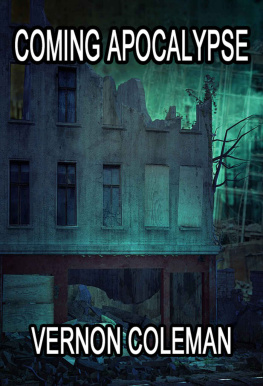B. Coleman - Hello Avatar
Here you can read online B. Coleman - Hello Avatar full text of the book (entire story) in english for free. Download pdf and epub, get meaning, cover and reviews about this ebook. year: 2011, publisher: MIT Press, genre: Politics. Description of the work, (preface) as well as reviews are available. Best literature library LitArk.com created for fans of good reading and offers a wide selection of genres:
Romance novel
Science fiction
Adventure
Detective
Science
History
Home and family
Prose
Art
Politics
Computer
Non-fiction
Religion
Business
Children
Humor
Choose a favorite category and find really read worthwhile books. Enjoy immersion in the world of imagination, feel the emotions of the characters or learn something new for yourself, make an fascinating discovery.
Hello Avatar: summary, description and annotation
We offer to read an annotation, description, summary or preface (depends on what the author of the book "Hello Avatar" wrote himself). If you haven't found the necessary information about the book — write in the comments, we will try to find it.
Hello Avatar — read online for free the complete book (whole text) full work
Below is the text of the book, divided by pages. System saving the place of the last page read, allows you to conveniently read the book "Hello Avatar" online for free, without having to search again every time where you left off. Put a bookmark, and you can go to the page where you finished reading at any time.
Font size:
Interval:
Bookmark:
HELLO
AVATAR
HELLO
AVATAR
Rise
of the Networked
Generation
B. Coleman
The MIT Press
Cambridge, Massachusetts
London, England
2011 B. Coleman
All rights reserved. No part of this book may be reproduced in any form by any electronic or mechanical means (including photocopying, recording, or information storage and retrieval) without permission in writing from the publisher.
For information about special quantity discounts, please email .
This book was designed by Katie Andresen.
Printed and bound in the United States of America.
Library of Congress Cataloging-in-Publication Data
Coleman, Beth.
Hello avatar / B. Coleman.
p. cm.
Includes bibliographical references and index.
ISBN 978-0-262-01571-4 (hardcover : alk. paper)
ISBN XXX-X-XXX-XXXXX-X (retail e-book)
1. Virtual realityPhilosophy. 2. Reality. 3. Avatars (computer graphics)Psychological aspects. 4. Human behavior models. 5. Shared virtual environments. 6. Human-computer interaction.
I. Title.
BD331.C565 2011
302.231dc22
2010042676
10 9 8 7 6 5 4 3 2 1
d_r0
HOW2
Foreword
Clay Shirky
I started using the Internet in the early 1990s, when the web was just a gleam in Tim Berners-Lees eye. One of the things I observed during the explosion of the online landscape at that time was a dramatic shift from the text-only medium it had been for its first twenty years of its life to one that was increasingly visual.
It was easy to extrapolate, from this embrace of the image, that the end-state of networked technologies would be our arrival in cyberspace and immersion in virtual reality, phrases bequeathed to us by science fiction author William Gibson and computer scientist Jaron Lanier, respectively. These phrases described a visual but mediated realm where we could interact with data and, much more important, with one another without regard to our geographic location.
By the late 1990s, the evidence for the spread of virtual reality was everywhereMark Pesce had created Virtual Reality Markup Language, a general-purpose tool for building virtual environments, and a variety of companies and technologies like Black Sun (later Blaxxun) and Alpha Worlds sprang up to offer computer-mediated visually
immersive experiences. It was easy to guess that virtual reality would soon become the principal way for people to interact with one another online.
And then a funny thing happenedit didnt. The second great change, not as immediately obvious as the Internets visual turn but just as profound, was that the tools of digital connectivity would become ubiquitous.
Back in the day (around 1994), we had our real friends, whom we saw at work and in the bar, and we had our imaginary friends, whom we saw online. These two groups were different because the people we knew in the real world were mostly not online (and in fact had mostly not heard of the Internet). Conversely, our online friends didnt live near us, so we couldnt see them in what we used to call real life, back when it didnt include digital communication.
The notion of cyberspace was supported by this social separationdigital networks were seen as an alternative to the real world, conceptualized as a place where we would go when we went online. By the early part of this decade, though, the real and virtual worlds had begun to anneal.
The first source of this change was growing ubiquity of access. In 2000, if you were under thirty, you were, statistically, online, and if you were under 20, most of the people you knew were online as well. For this cohort, digital networks were increasingly an augmentation of the real world, rather than an alternative to it.
Ubiquity of access was followed by ubiquity of connection. A whole host of technologies, from laptops to wireless networks to pocket-sized computers masquerading as phones, forced us to give up the notion of connecting as travel, with the destination being online, a place we would go. To take advantage of digital communications and use digital tools to read and write digital traces from our friends and colleagues, we no longer had to sit in particular chairs in front of computers with special wires in the back. Instead, we could be periodically connected, in short bursts, all the time.
For most of us thinking about media, these two notionsof a visually immersive cyberspace and of portable, ubiquitous connectivityexist as alternate interpretations of contemporary behavior. On the cyberspace side, Second Life and Cyworld and Habbo Hotel are visual environments built around architectural metaphorsrooms in which to socialize or visual scenes of travel as we move to different locations in order to converse with others. These spaces were meant as platforms for thick, immersive experiences that were meant to make the real world fall away by copying enough of its affordances and constraints to provide a partial digital substitute.
On the ubiquity side, we have services like Facebook and Flickr and Foursquare, thin tools that allow us to communicate and to share things with one another but which dispense spatial metaphors in favor of emphasizing the connections and locations of the real world over anything immersive.
These notions have generally been treated as incompatible viewsif we think of the network as a cyberspace and ourselves as actors enveloped by it, we will analyze our life with the network in one way; if we think of the network as a light, ubiquitous communications substrate linking real-world actors and actions, we will think of it in an alternate way.
What Beth Coleman proposes to do in Hello Avatar is nothing less than reconciling those two visions, providing a means to escape the seeming incommensurability of two competing models. Coleman understands media use is a whole complex of cultural practices that represent not alternate visions but alternate choices, sometimes engaged in rapid succession, or even simultaneously. She presents the use of these tools not as fealty to one or the other metaphor for interpreting our behavior but rather as a whole, organic set of explorations and practices, and she wants to help us understand it that way as well.
The distinction between immersive and lightweight uses of the network was only ever theoretical anyway, happily ignored by the actual users of the technologies. People who play World of Warcraft also send text messages to each other, and many of their communications outside the game world are with people they know in the game world as well. The different forms of communication just represent different ways for the same two people to communicate with one anotherthe presentation of facets in everyday life.
These alternate tools and practices, assumptions and traces, arent alternates at all when we take a holistic view of the actors involved. Coleman sets aside competing technological metaphors for participation in these networks and shifts her view (and ours) to center on the human actors who are cheerfully and fruitfully crossbreeding these separate media experiences. Our choice of expressing selfhood in various ways, in a medium with this much fluidity and malleability, means that even when we merely set out to consume mediated experiences, we end up as designers of those experiencessometimes by embracing that possibility as an alternative to a norm of pure consumption, but often just as a side effect of the ways the tools work and the way we work with them.
Colemans framing image is of an avatara constructed trace, sometimes crafted, sometimes recorded, and often boththat represents us in digital congress. The word avatar, borrowed from the Hindu idea of the manifestation of a god in a form that can be seen in this world, has been pressed into service to mean a manifestation of a person projected into a digital world.
Next pageFont size:
Interval:
Bookmark:
Similar books «Hello Avatar»
Look at similar books to Hello Avatar. We have selected literature similar in name and meaning in the hope of providing readers with more options to find new, interesting, not yet read works.
Discussion, reviews of the book Hello Avatar and just readers' own opinions. Leave your comments, write what you think about the work, its meaning or the main characters. Specify what exactly you liked and what you didn't like, and why you think so.







